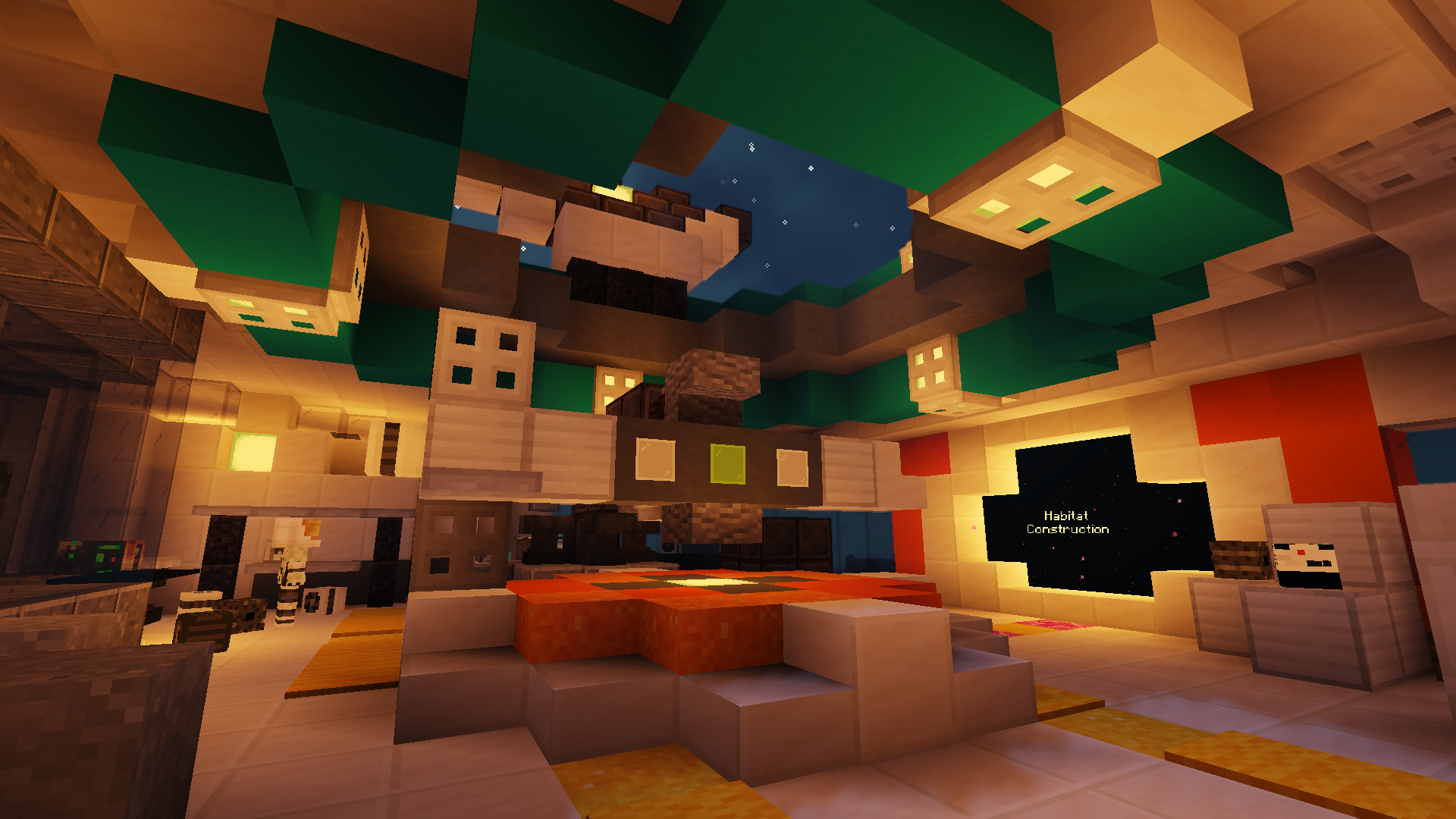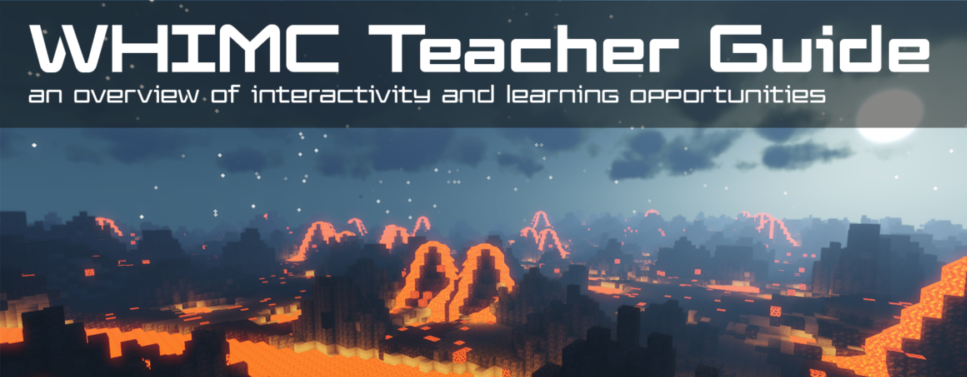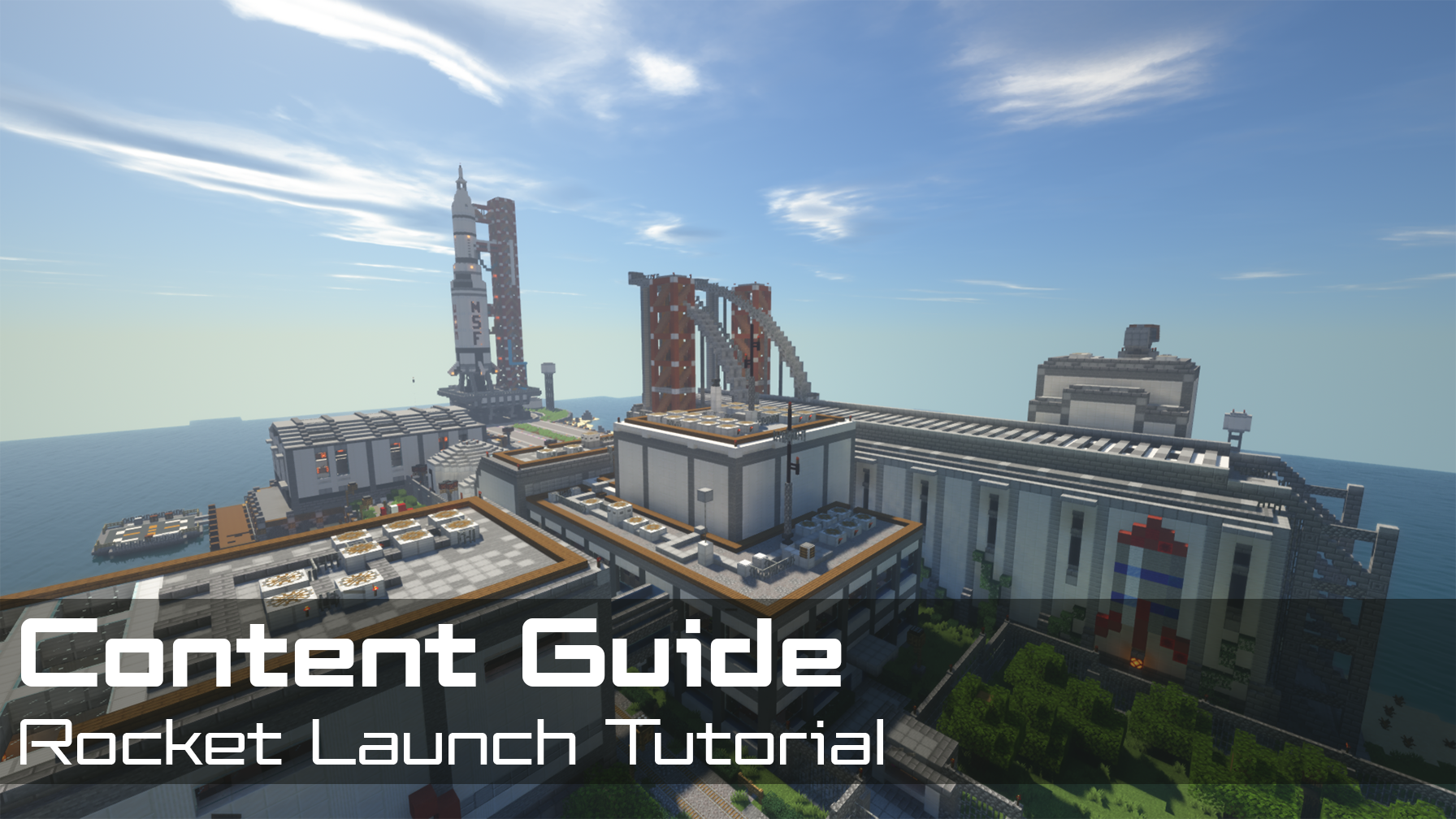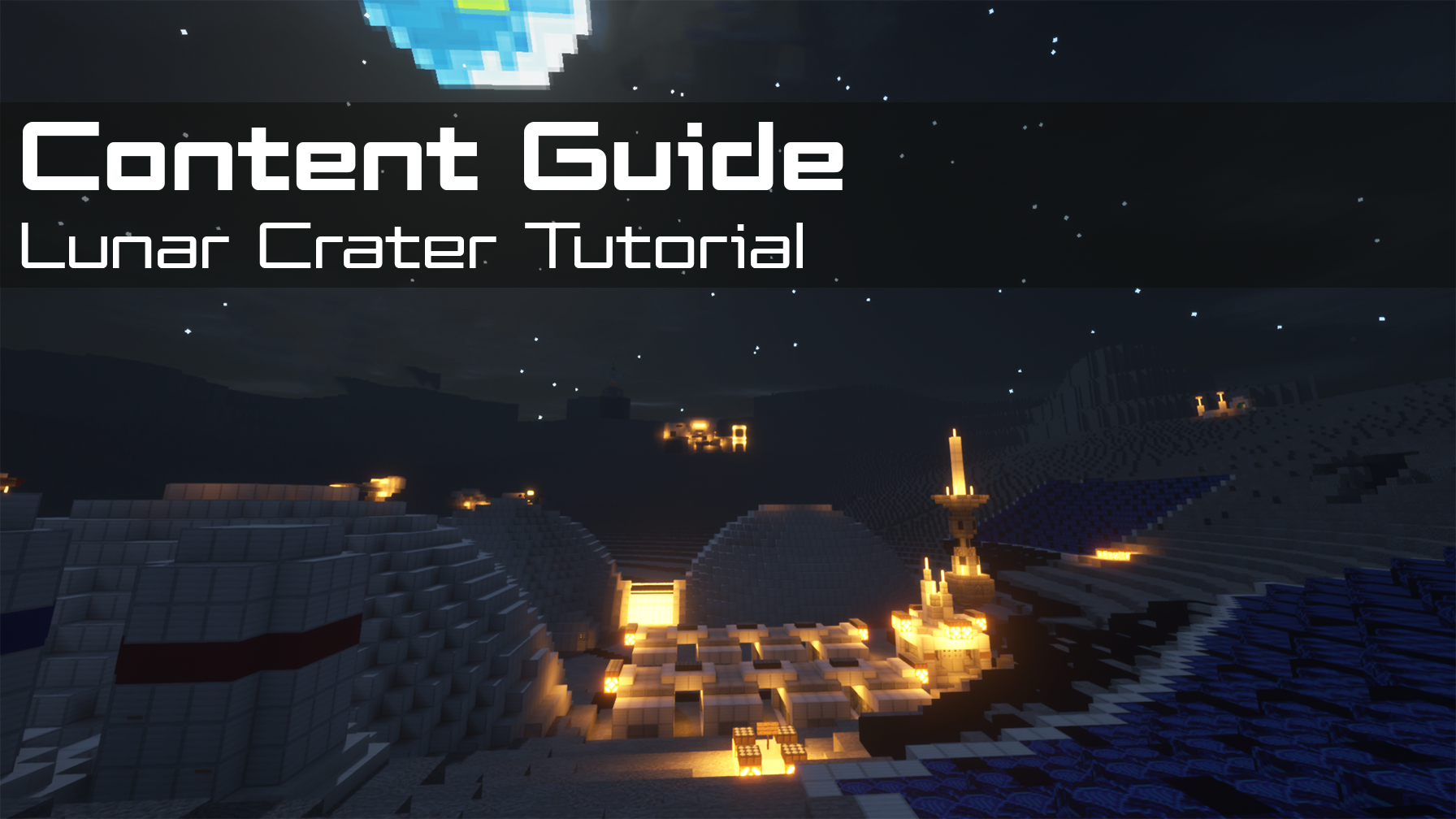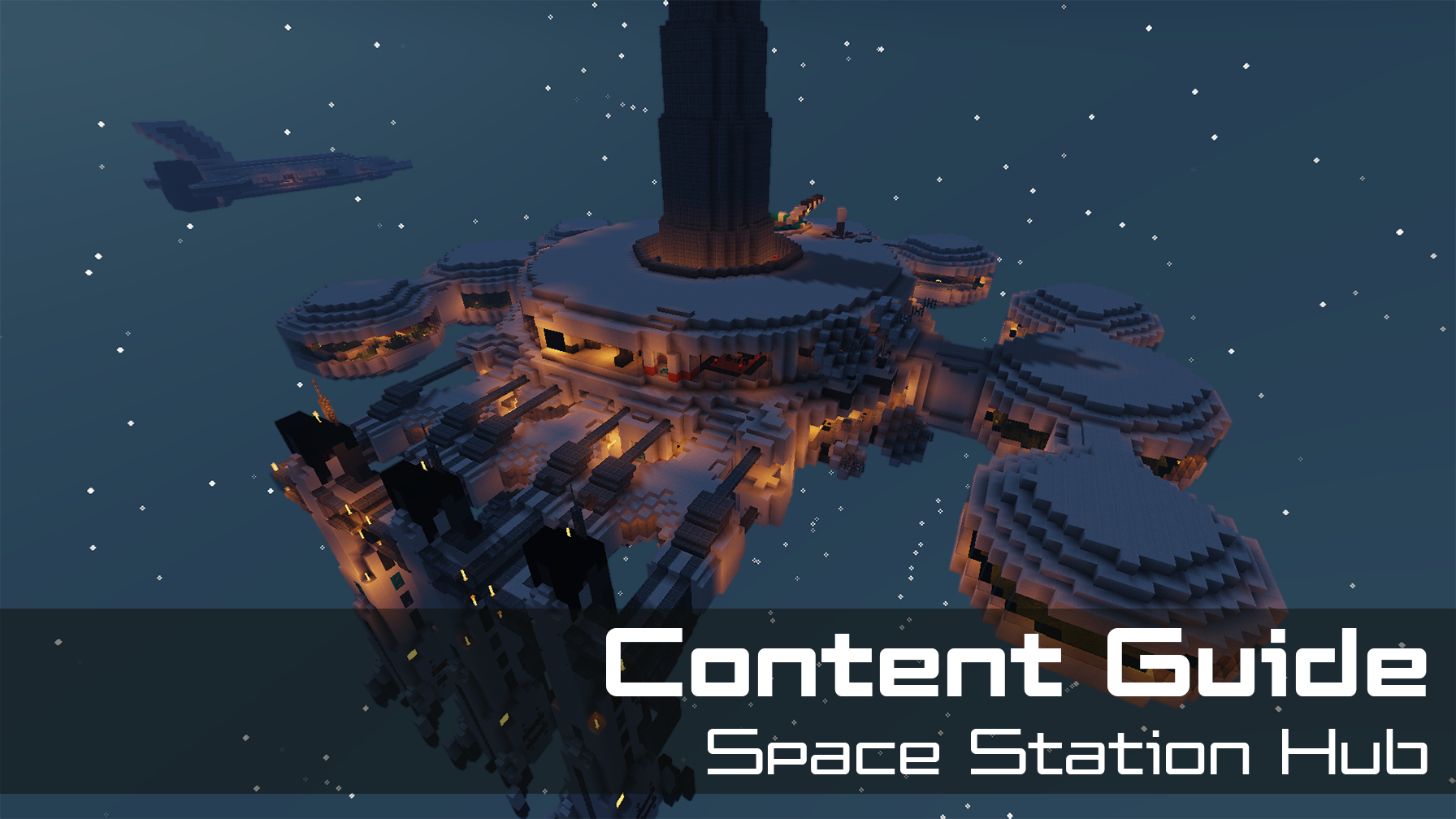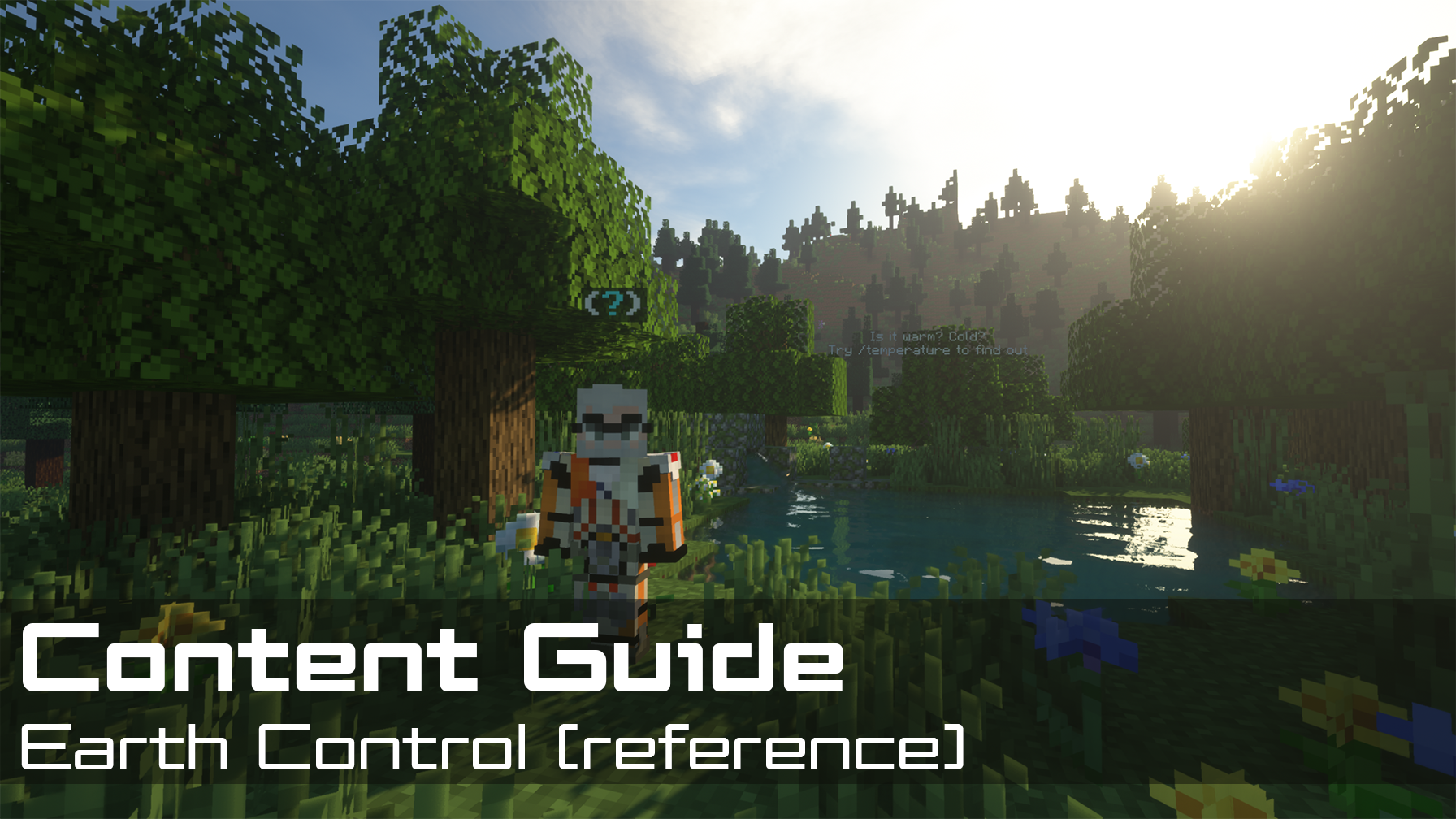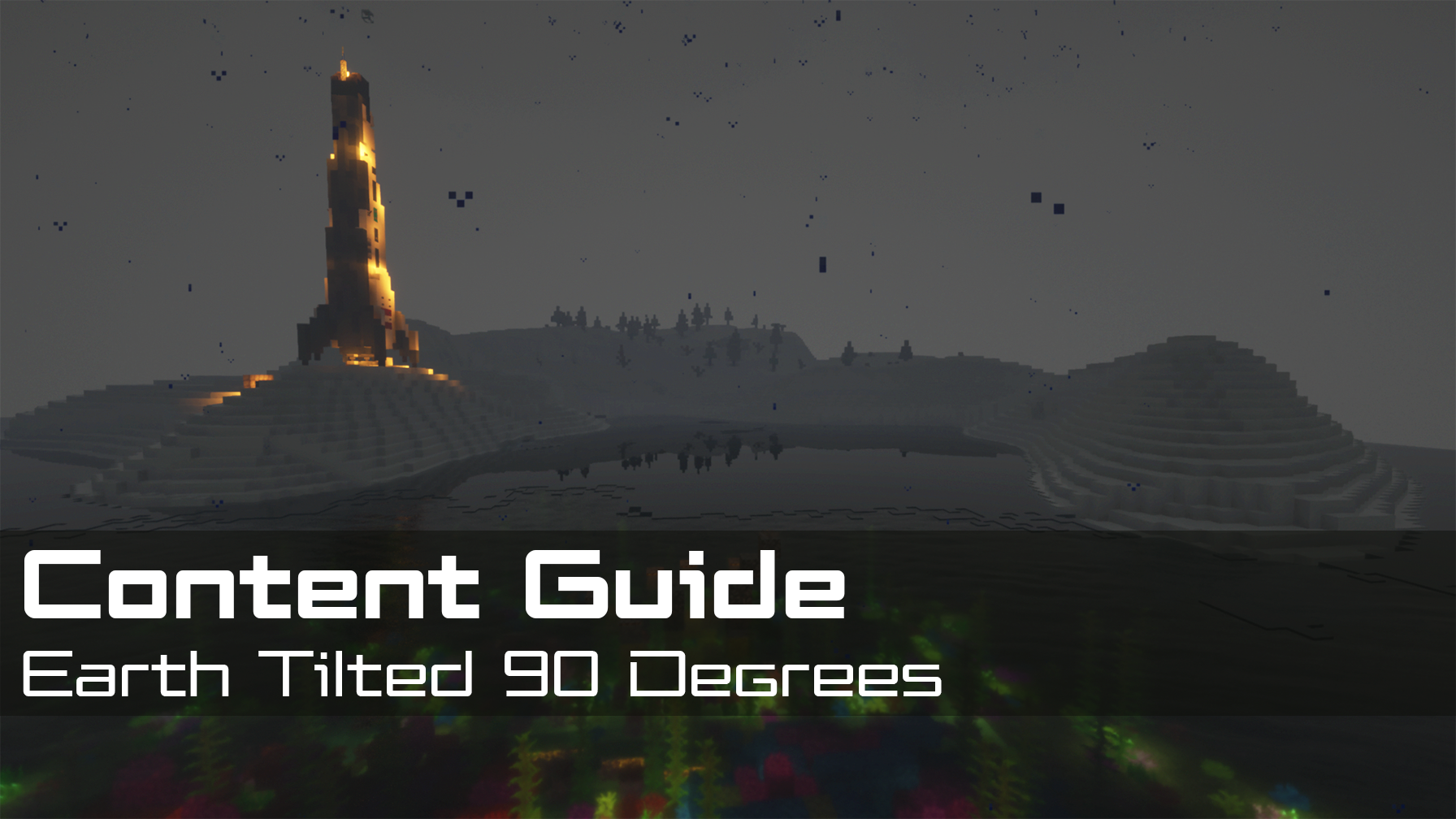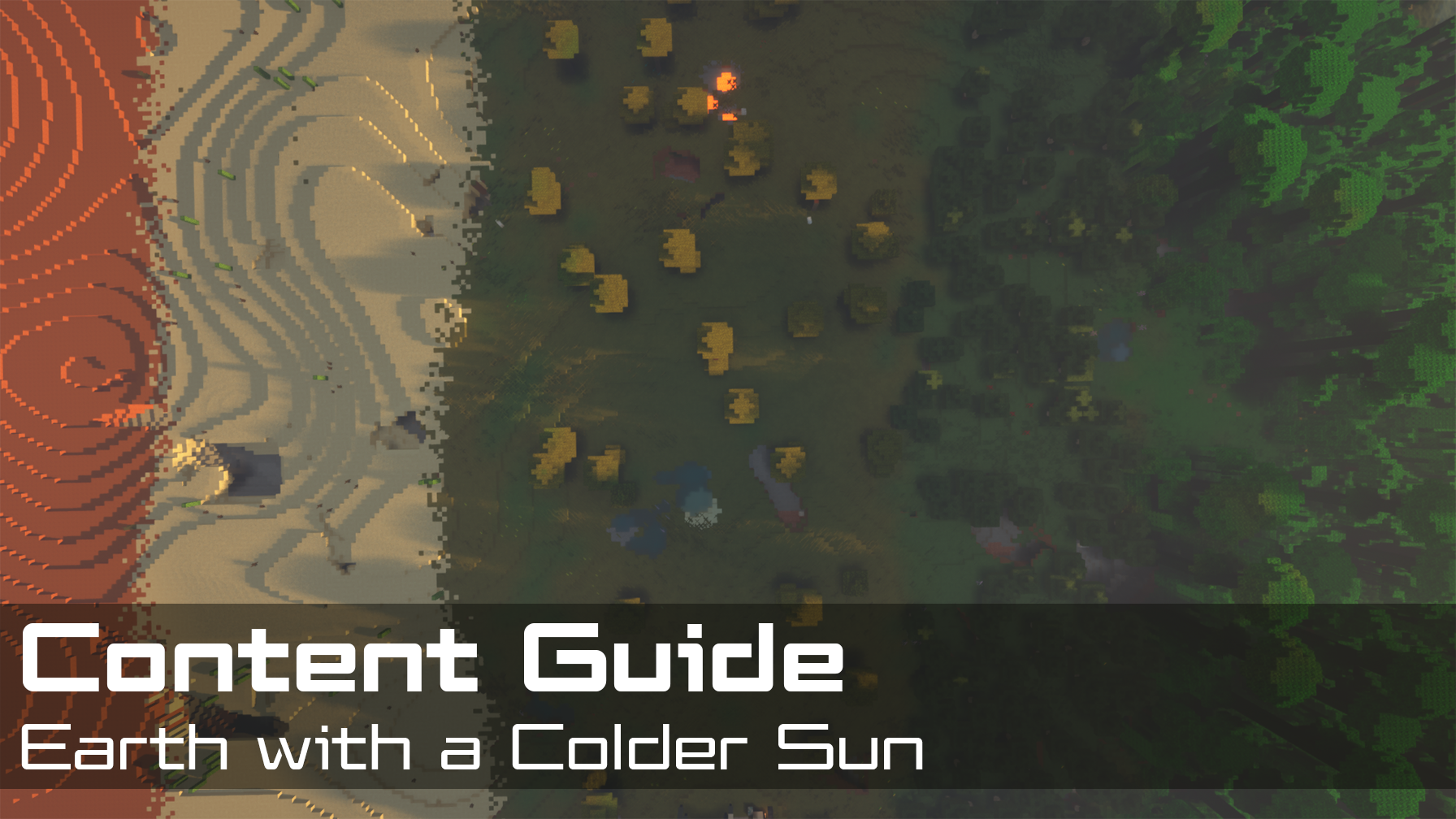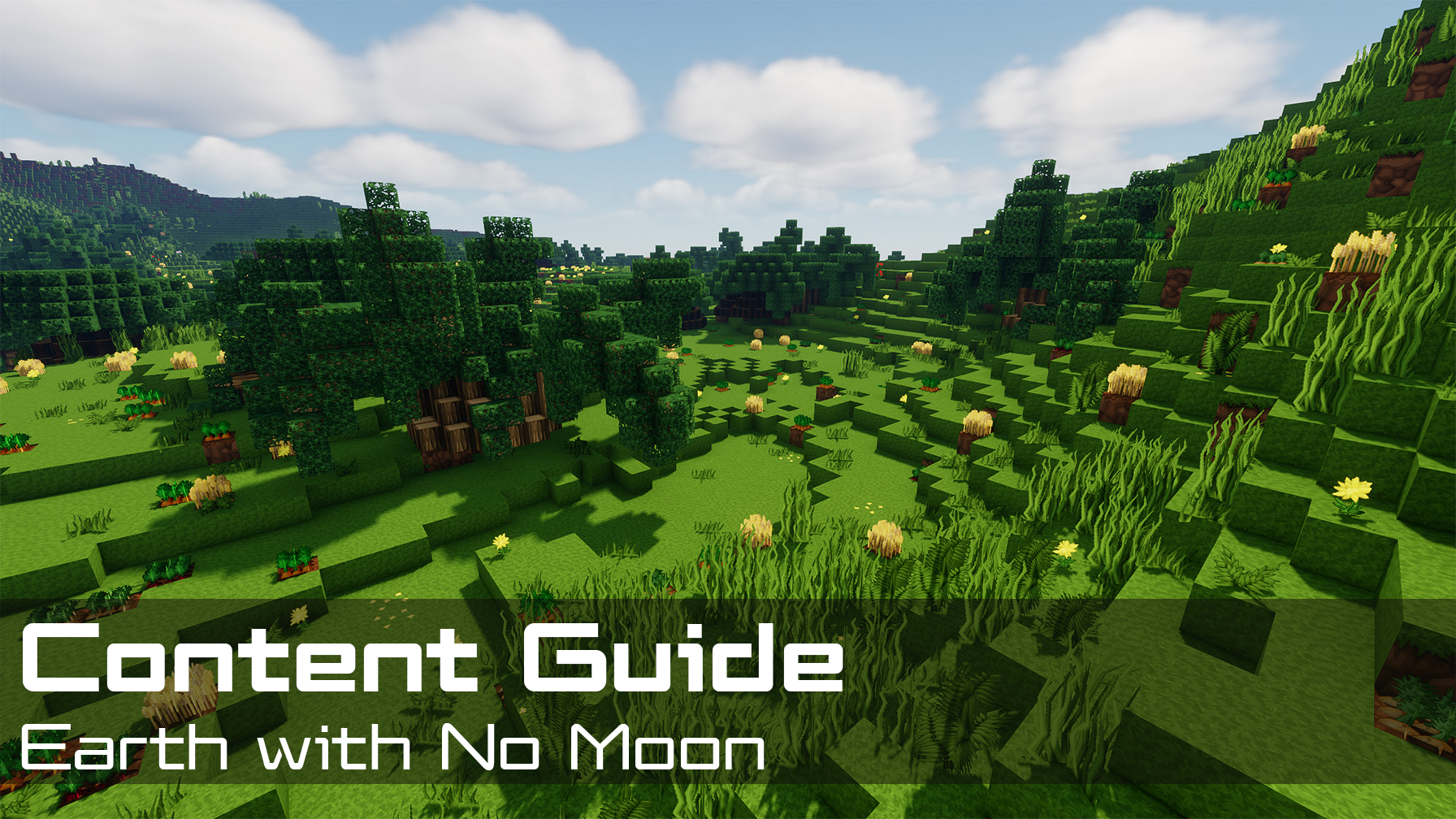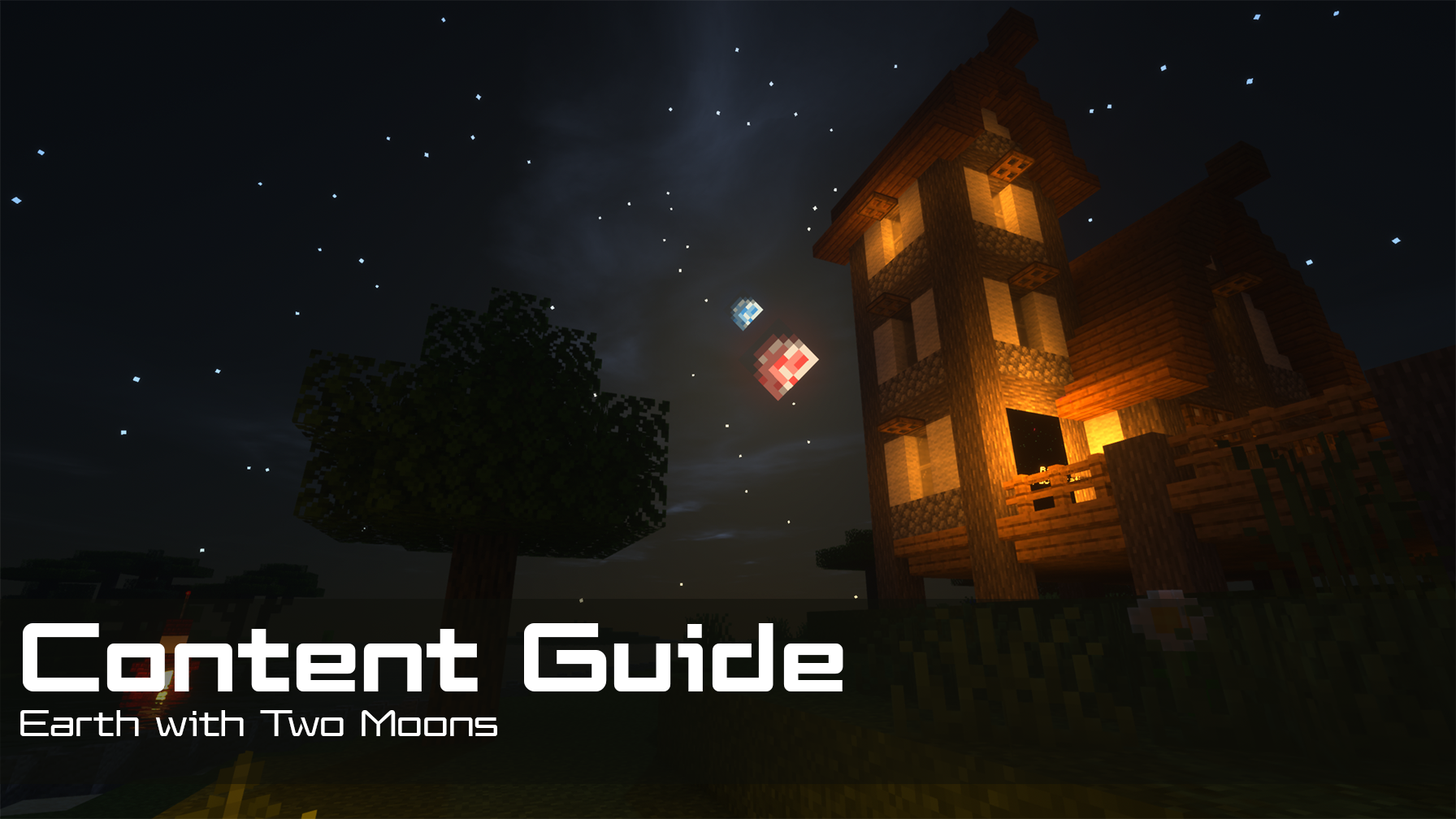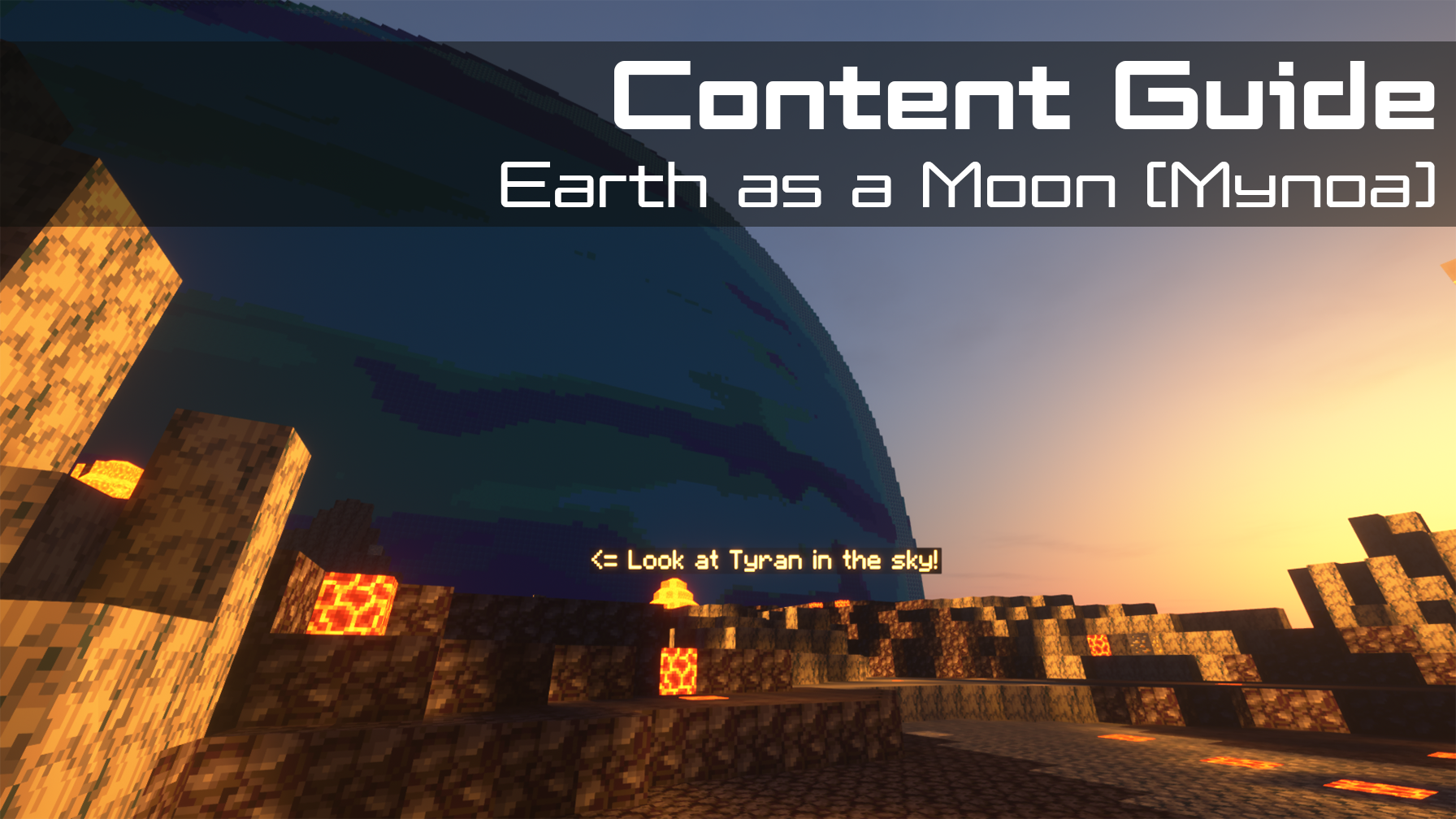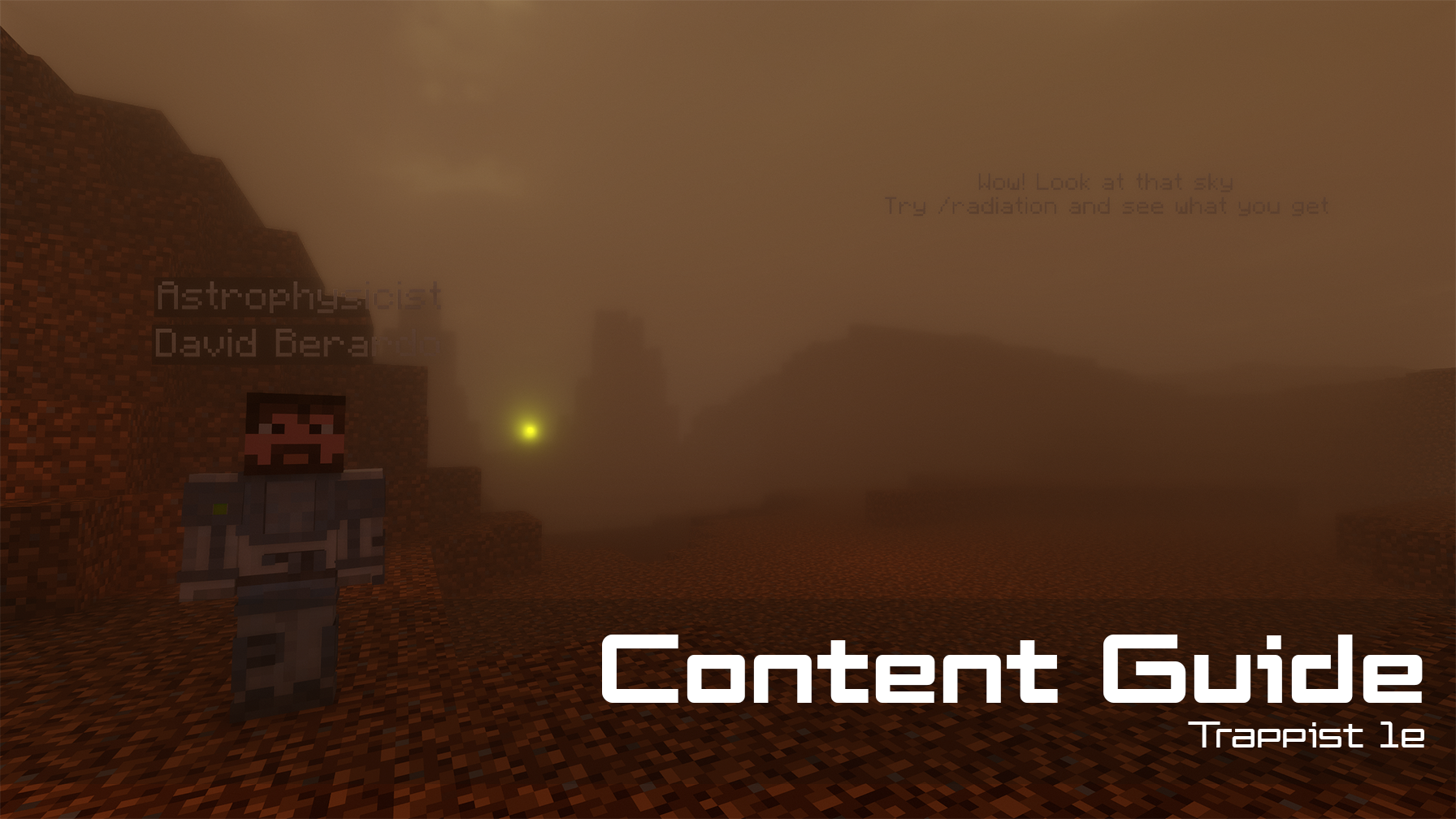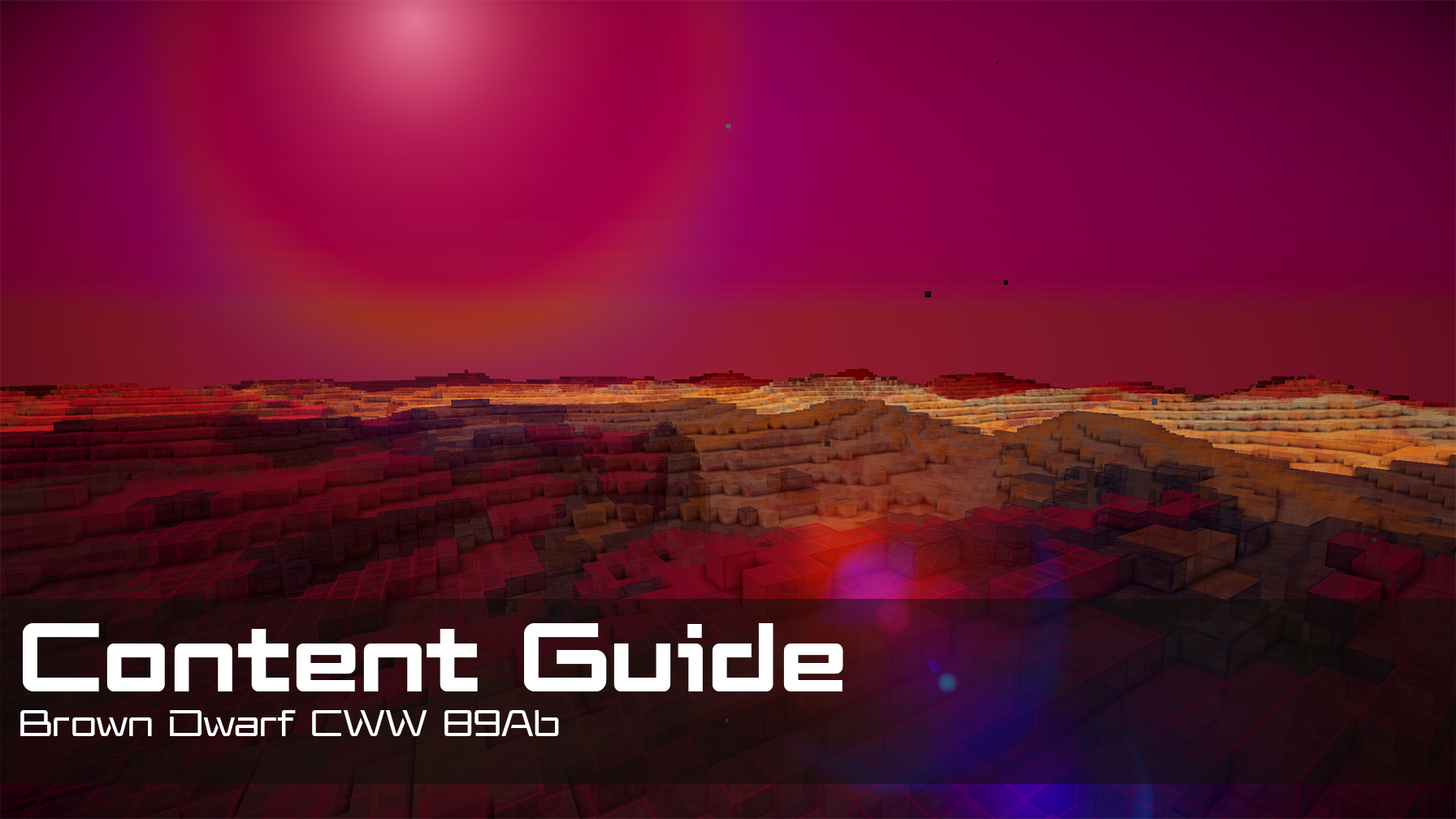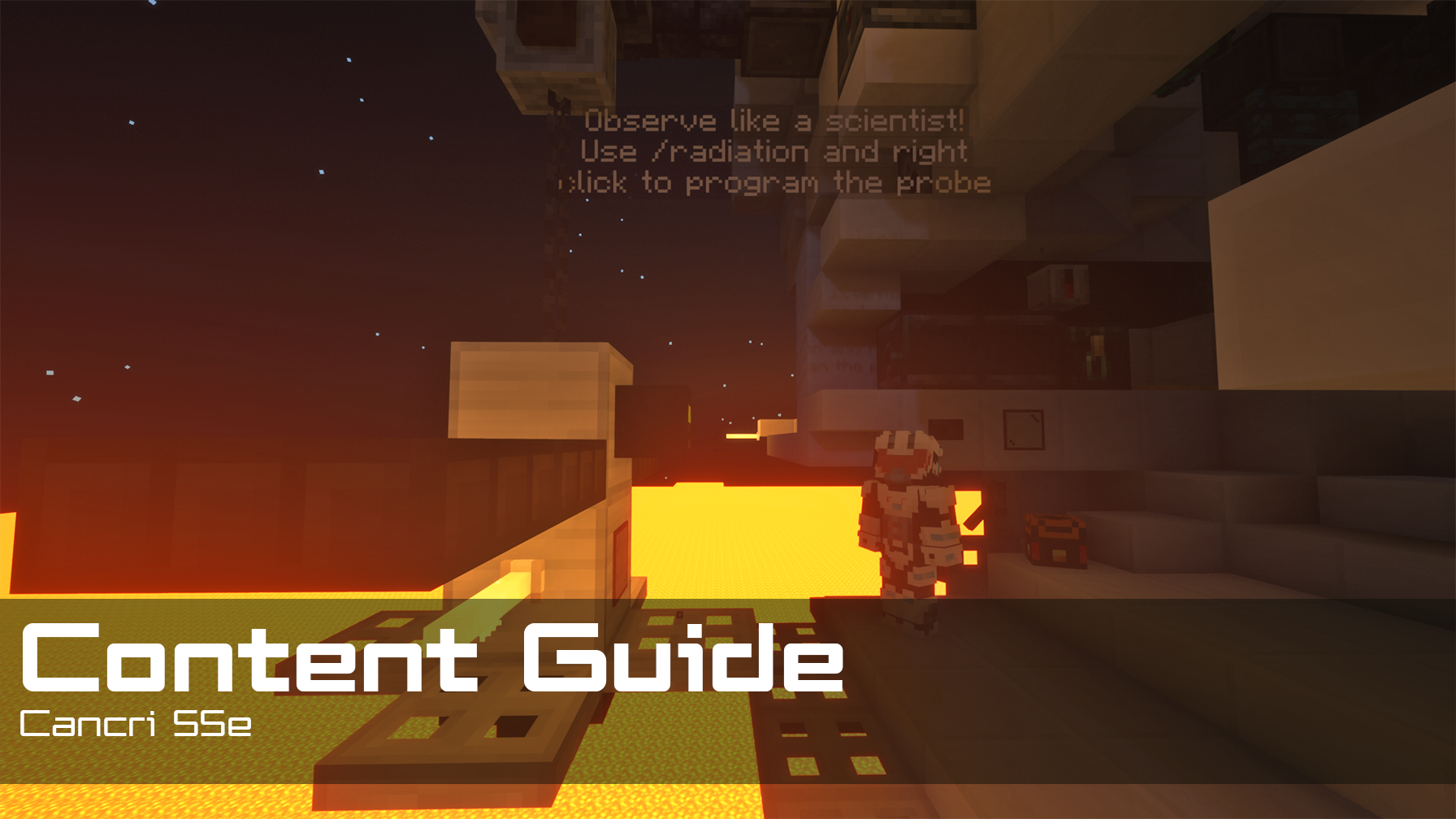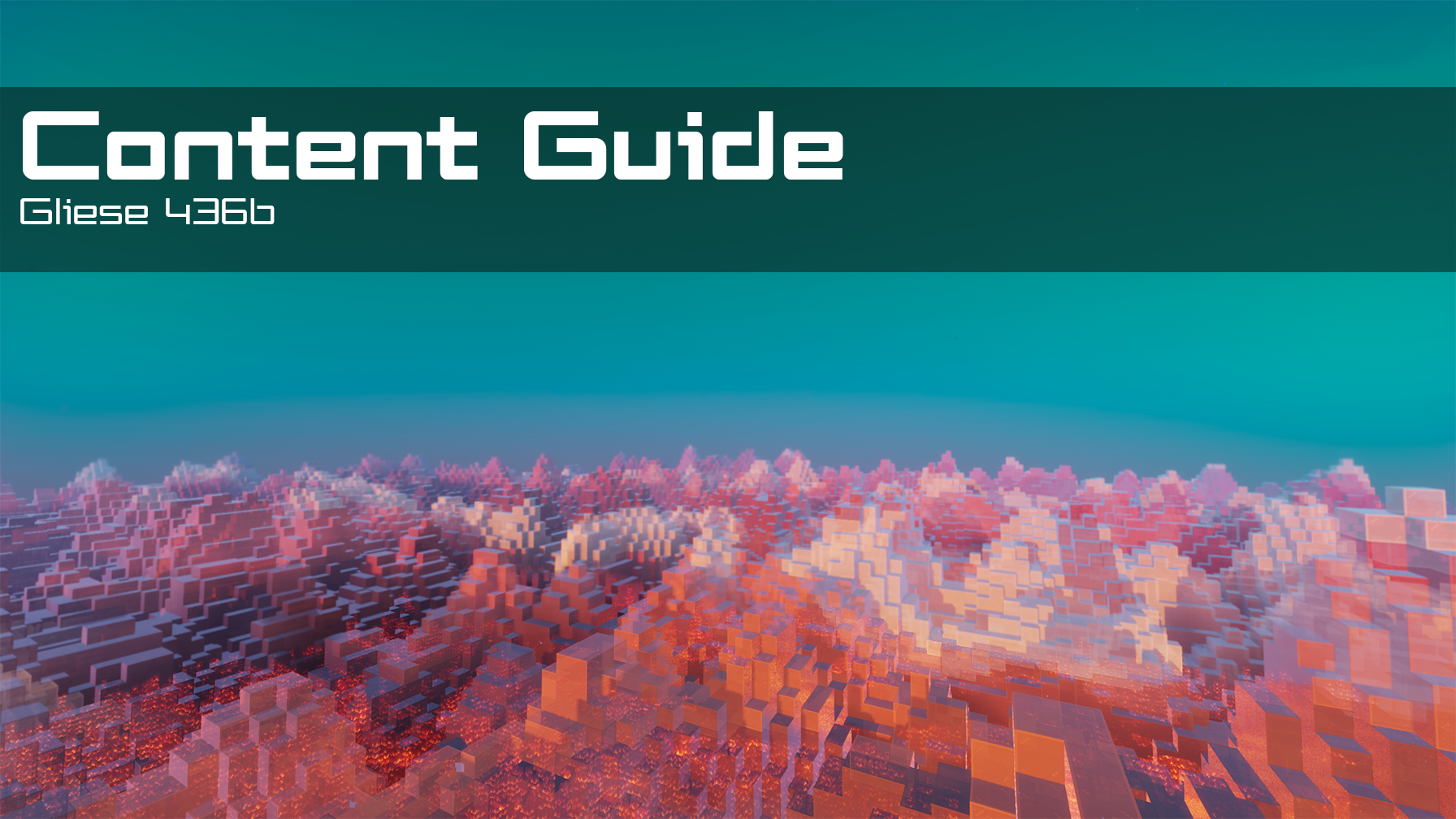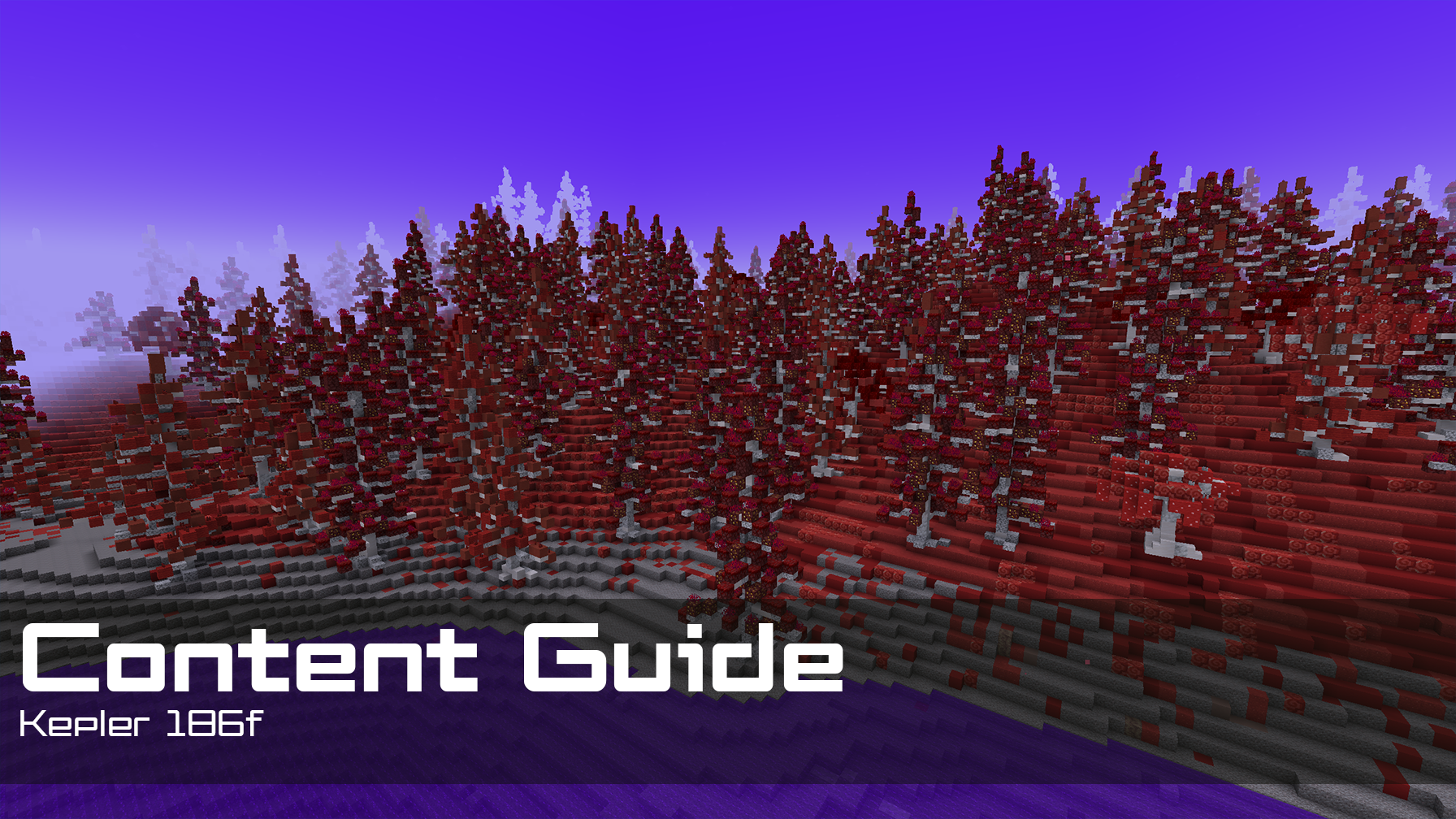Check out our online guide below or the book PDF created by the Ateneo Laboratory for the Learning Sciences:
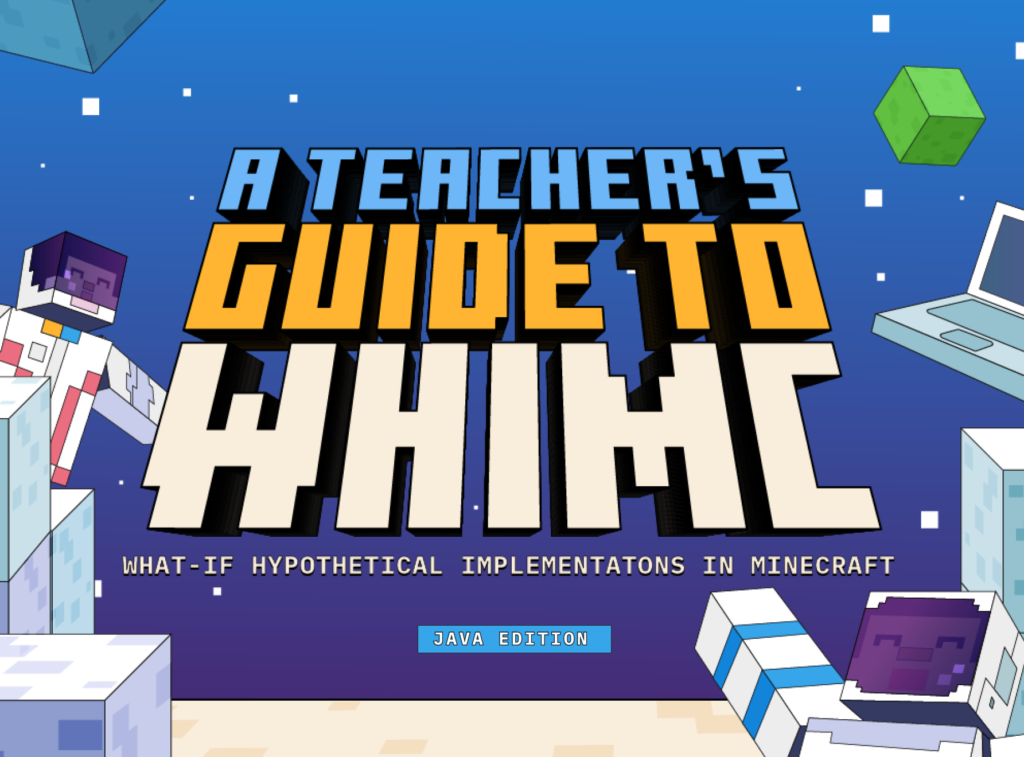
Goals
Our primary goal is to create a fun and engaging astronomy simulation game that generates continuing interest and wonder in STEM. Our secondary goal is to foster learning experiences and activities that align with recognized standards for use in STEM classrooms or workshops.Requirements
Participants will need a Windows or OSX Computer with Minecraft Java Edition. See our Getting Started Guide for more information as well as how to sign up for the server. It is recommended for learners ages 9 through 14 who have some familiarity with Minecraft or keyboard-controlled games.How Parents or Educators can use the WHIMC Server
The WHIMC server is built to support 2 kinds of learning experiences: 1. Individual participants playing alone at home or separated from classmates without an active instructor. This can be done asynchronously over as many sessions as are desired. This approach makes use of the quests system and supportive AI agents and is recommended for parents or settings like open-play study hall. 2. A group of participants playing in a classroom or informal learning setting with a dedicated guide or teacher. This approach is best suited to integration with specific learning objectives and complementary activities such as demonstrating planetary physics with balls, using tools like the PBS Nova Exoplanet Lab, drawing potential alien world habitats and more ideas found in the educators section of our website. It is recommended that teachers DO NOT use the quests system for a WHIMC workshop or class but instead follow the walk-through and then teach students the game-based tools (below) and assign quests themselves.WHIMC Server User Experience (UX) overview
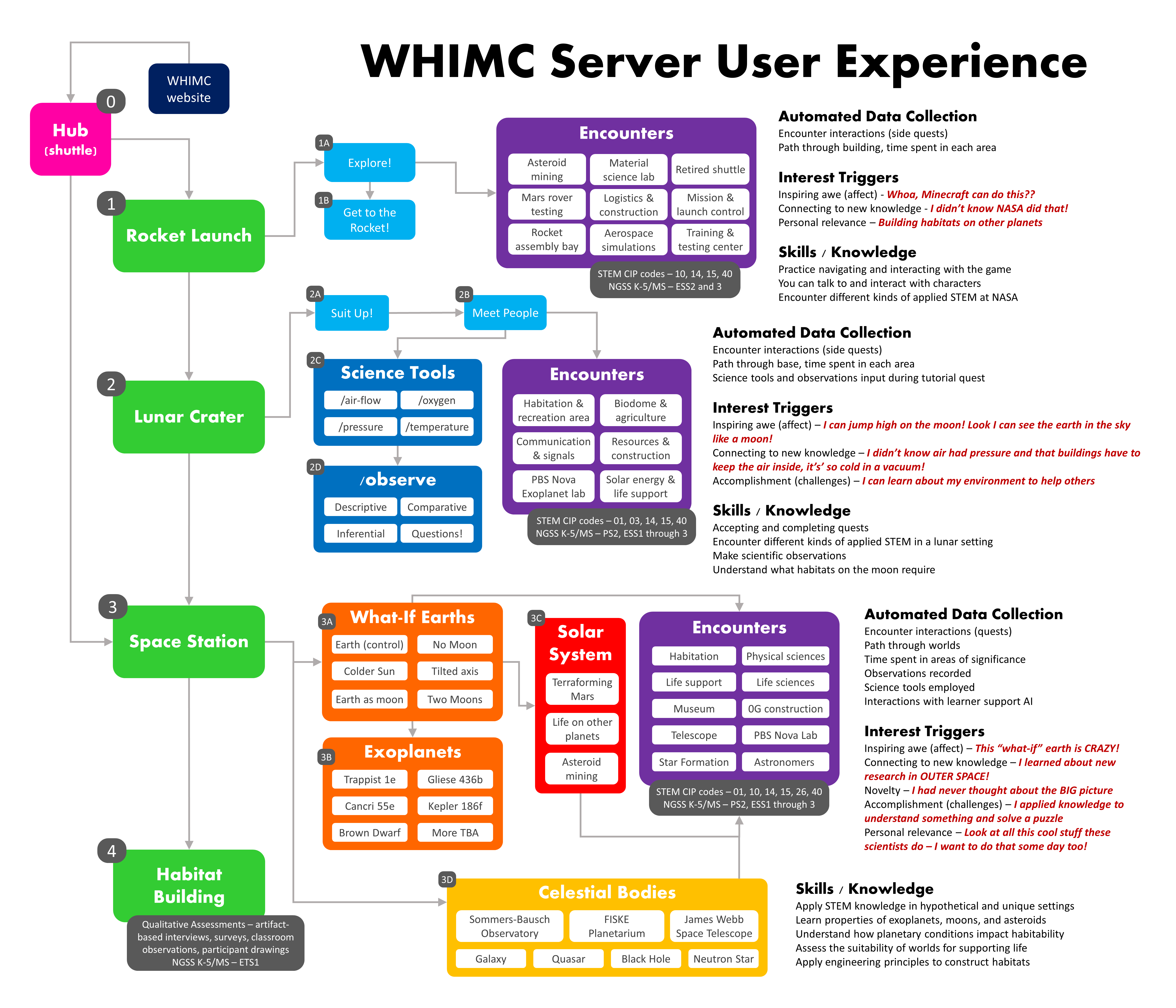
To use this tool, press T to open the chat. Then type /sciencetools measure and hit space to see what tools are available. You can type any tool as a short command, like /gravity or /year.2. Learn to /observe like a scientist using prompts and templates to document and compare notable features in simulations.
To use this tool, press T to open the chat. Then, type /observe followed by a space and a written observation. Press enter to place that observation in the world. OR you can type /observe and press enter to open the templates menu
3. Help learners make use of the minimap and quests journal to know where to go and what to do. The map is given in Rocket Launch and the quests journal in Lunar Crater:
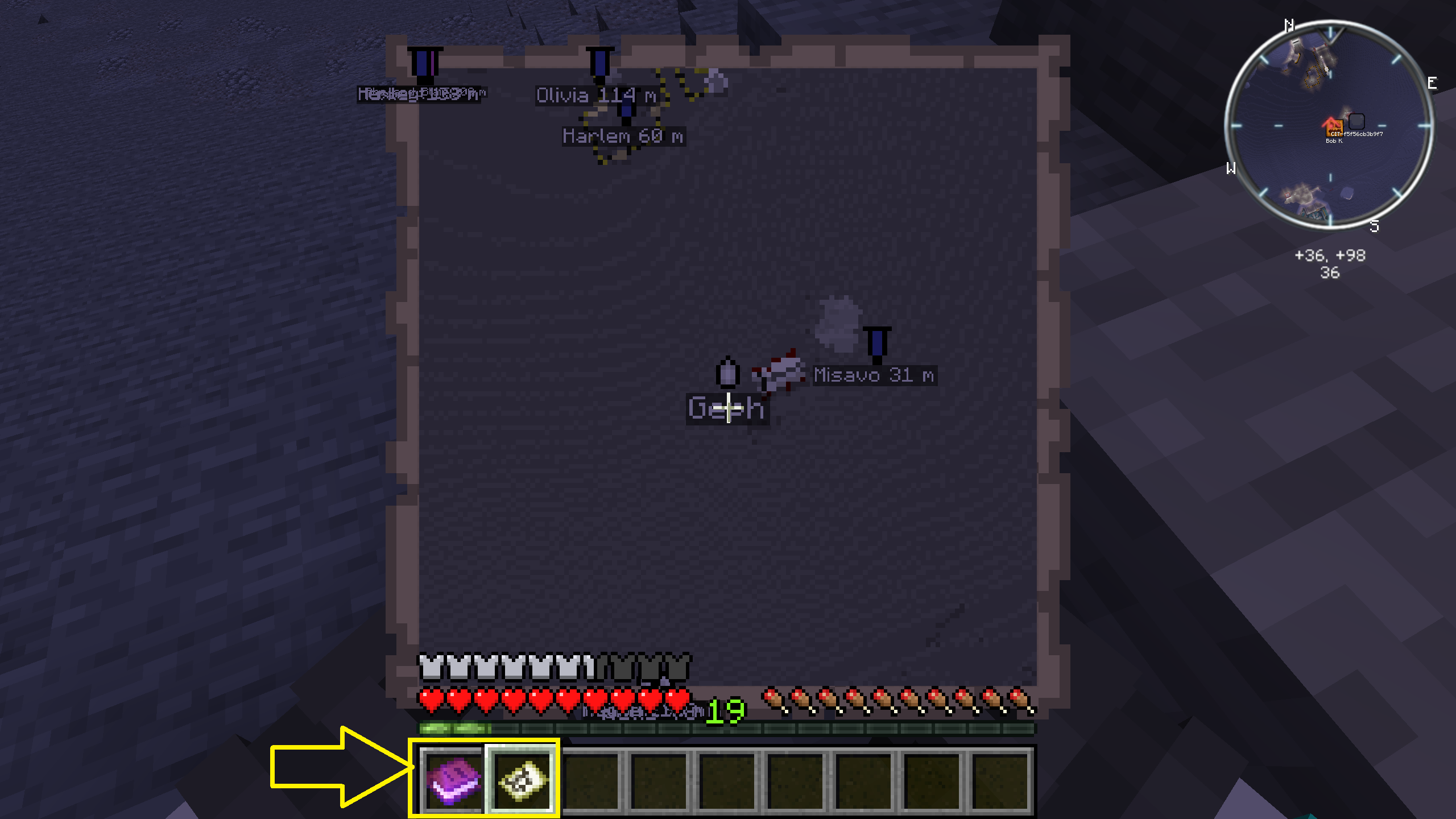
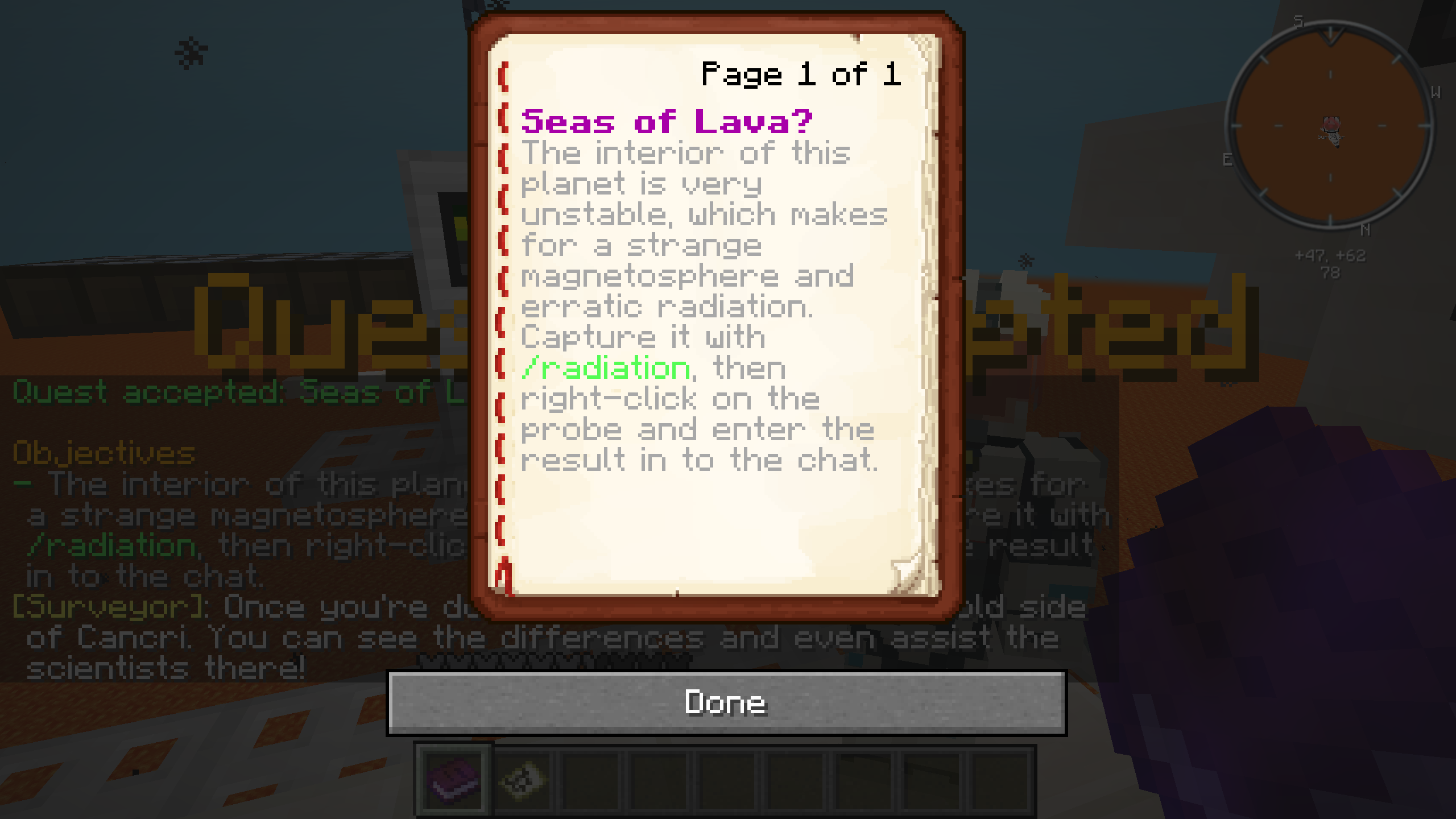
If participants ever lose their quests journal they can get it back on lunar crater or in the space station hub:
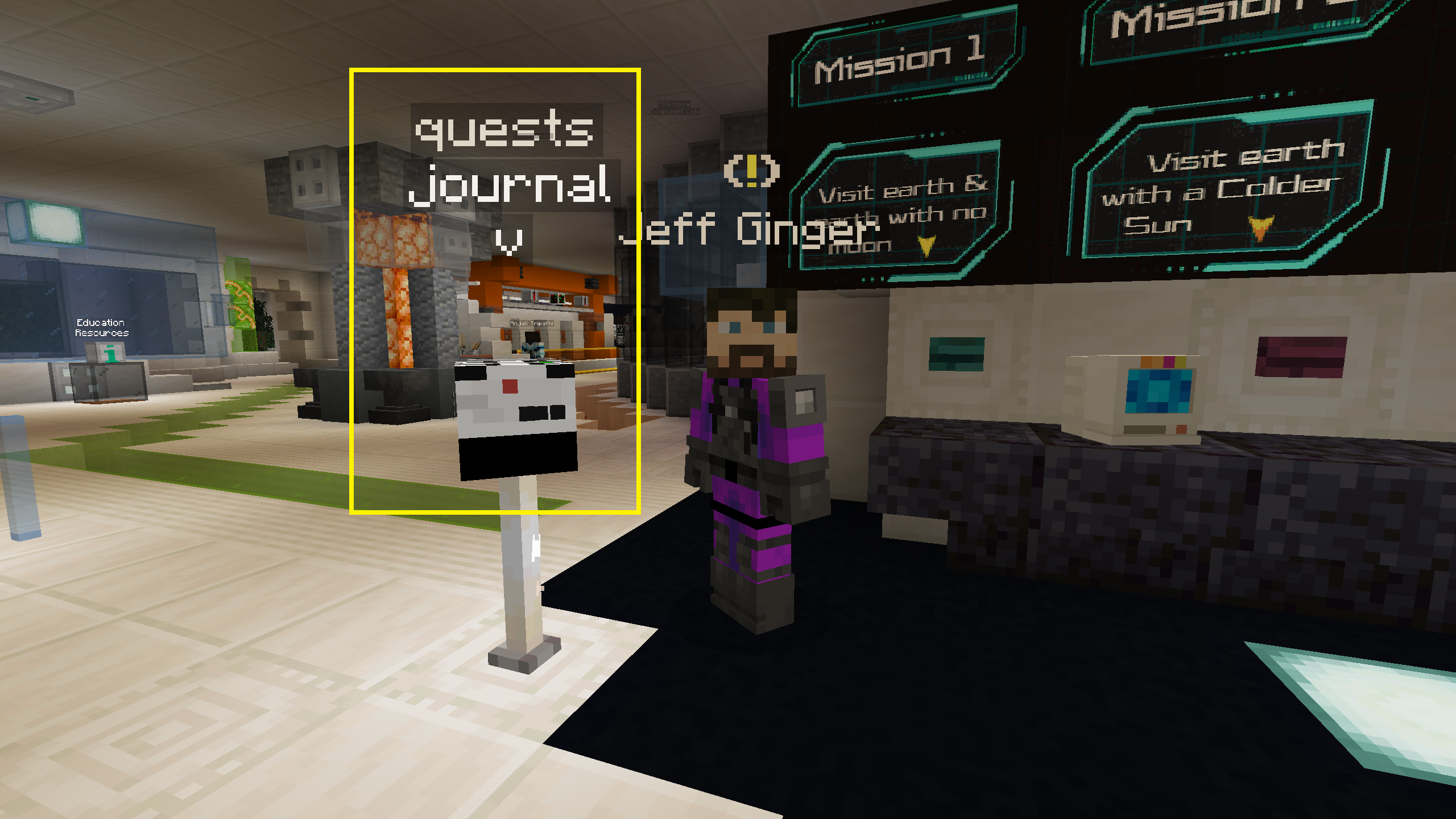
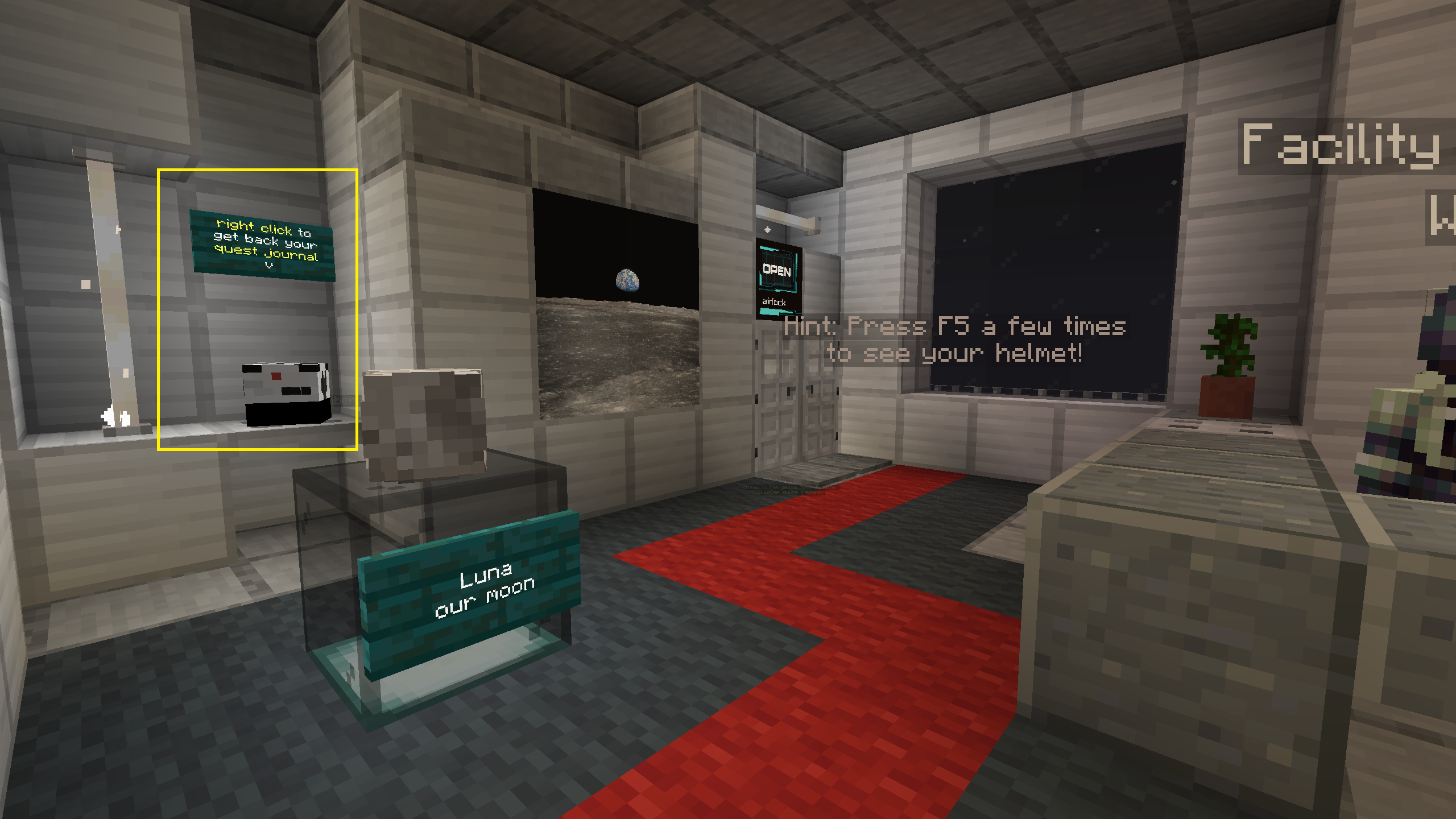
| Map | Required Quest | Purpose |
|
Rocket Launch |
Get to the rocket |
Introduce players to quests, indicate they’re going to space, give them something to look for as they explore |
|
Lunar Crater |
Welcome to lunar base LeGuin! |
Further introduce quest mechanics, talking to NPC’s, need for space suit, low gravity, direct to central moon domes |
|
Meeting people |
Learn about different kinds of scientists, each one gives you a quest to learn a science tool (custom2) |
|
|
Feeling the pressure |
Harlem explains /pressure - buildings have their strength shaped inward to keep air INSIDE, which is trying to burst out |
|
|
What’s Cooler than being cool? |
Misavo teaches about relative /temperature and water states/needs on the moon |
|
|
Not-so-solar-wind |
Huxley indicates need for /airflow (or /wind ), encourages characters to explore habitation areas to understand aspects of life on the moon, from food to health to keeping clean |
|
|
A breath of fresh air |
Olivia asks players to help find an airlock /oxygen leak, which is a chance to explain why we have airlocks and how air is a limited resource in a place like the moon |
|
|
Space station access |
Reminder to complete per-person tasks, not just talk to them, requires two clicks
|
|
|
Space Station, and “What-If” earths |
Explore [What-If] Earths |
A whirlwind tour of the starter “What-if” worlds on the WHIMC server, where players observe earth in its default state and then later imagine and explore earth with dramatically different
astronomical conditions |
|
No Moon |
Observe with the wind |
An alternative to the observation tutorial, asking players to make on observation with /wind
to gain permission to leave the planet and visit other “what-if” worlds |
|
Colder Sun |
On the edge |
Visit Astronomer-Artist Jorge Perez-Gallego on the edge of the desert and then travel around the planet to make 3 /observe commands noticing the tidal lock conditions |
|
Tilted Earth |
Time traveler |
Astrochemist Clara Sousa-Silva invites players to see what happens to animals as the planet changes seasons and conditions rapidly over an entire year |
|
All Exoplanets |
Tour de exoplanet |
A truly fantastic set of visits to exoplanets that real live humans will probably never see in-person, plays learn about science-related variables that would make life very difficult in these extreme worlds
Reward: Scientist Rank - gain access to solar system worlds |
|
Gliese |
Ice on fire |
Set an IR sensor probe’s orbital distance by checking an /altitude measure above Gliese, a world of ice on fire |
|
Cancri |
Seas of lava? |
Determine just how dangerous /radiation is above the molten exoplanet of Cancri |
|
Trappist |
Pond trap |
Investigate the composition of caldera liquids found on the surface of the semi-habitable world of Trappist by using /atmosphere |
|
Kepler |
Collect a sample |
Study a sample of plant life to see how light of different wavelengths has changed its composition |
|
Brown Dwarf |
Brown Dwarf OR planet? |
Confer with real-life astronomer Theron Carmichael to determine if the planet we’ve sent a probe to is a Brown Dwarf or not by checking /atmosphere and /observe - players become the probe to go inside the planetary body! |
| Map | Secondary Quest(s) | Purpose |
|
Rocket Launch |
Reusable Rockets |
Introduces the connection between environmental concerns and space exploration, as well as a chance to meet a real PBS scientist - Anjali Tripathy |
|
Lunar Crater |
Exoplanet Lab |
Connect to external PBS Nova Lab activity |
|
Lunar Crater, Earth Control |
Observation Tutorial |
Teaches about three kinds of more scientific ways to observe - descriptive, comparative, inferential ; optional but grants the “observer” status upon successful completion |
|
Earth Control |
Baseline (optional) |
Invites learners to take some baseline measures of astronomy-related variables for later comparison, including atmosphere, gravity, magnetic field and characteristics of the sun and moon |
|
Space Station |
Singing plants |
Anjali Tripathy implores players to think about recycling as more than just trash but also air and water and then asks them to release auxiliary supplies generated by the biolab upstairs |
|
Colder Sun |
Cave Life |
How might life for flora and fauna (or humans) look in these extreme worlds? Meet characters in sheltered caves who explain more. |
|
Tilted Earth |
Measuring Migrations |
A chance to find more animals and learn about severe and rapid weather conditions impacting more species than just mammals. |
|
Mynoa |
That’s no moon |
Visit each side of the Mynoa (Earth as a moon) observing the differences Tyran (Neptune-size moon) makes along the way (subsequent quests below) |
|
Solis defuit |
Think about and make an observation about why the area is dark, take a temperature measurement, and observe why the temperature is so low. |
|
|
Wanna knowa mynoa? |
Take a measurement of the temperature in this area and observe why it is different as compared to the close side of Mynoa. Then, measure the magnetic field and observe why it is so strong in the shadow of Tyran. |
|
|
Mynoa museum mania! (custom31) |
Observe the museum’s enormous display of Mynoa and Tyran size difference! Then, spur curiosity about the remainder of the planet through |
|
|
Two Moons |
Lunar loop |
See what the world looks like with both high and low tide and visit the volcanic moon of Lluna! |
|
Seeing double |
Notice the effect of two moons on tides, understand tidal bulge |
|
|
What’s the time? |
Think about how two moons affect the length of day |
|
|
Build |
Alien habitation |
Visit this period’s build world challenge! |
